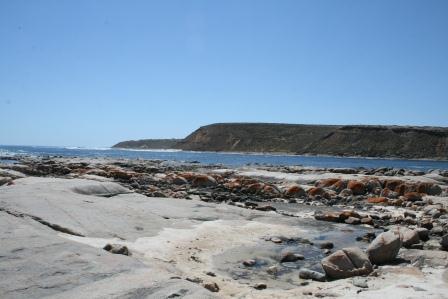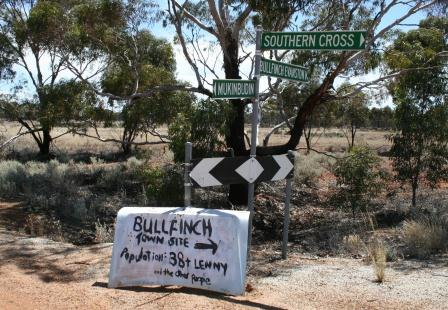Here it is – the next blog post and sadly, this will probably be the last one that describes new and exciting discoveries!
From Eucla we were once again underway at the ridiculous time of 6.30am and crossed the border into SA a very short time later, putting the watches and clocks forward a further 1 hour 45 minutes. If we hadn’t already gained two hours crossing into WA back in early June, we would have been seriously sad about losing so much time from our already well-advanced three score and ten allowance!
As that huge piece of limestone which makes up the Nullarbor Plain now comes right to the coast and the Eyre Highway goes along that coast, there were important sight-seeing opportunities ahead. Interestingly though, the landscape was still not bare and boring – it was reasonably well-vegetated with what looked to us like mallee scrub and, as such, afforded much potential for discussion about why this was so!
Lookout 1 was soon reached, so we duly pulled in and walked the short distance to the viewing point. Here we were able to look west and see the start of the Bunda Cliffs, where the limestone plain drops beween 40 and 90 metres into the Southern Ocean for an unbroken 200km from here to Twin Rocks at Head of Bight.
Lookout 2, further along the highway, gave us a
chance to see the cliffs booth west and east and what an impressive sight and
one which evoked the same feelings of standing on the absolute edge of the
continent that we had what seems so long ago on the west coast. The colours in the limestone were beautiful
and it was awe-inspiring to look down and think about the forces that have been
at work for so many millions of years to shape this coastline. We learnt from the interpretive signage here
that the sediment which falls into the ocean as the cliffs are eroded is
carried away by the sea (we didn’t learn that, as we did already know a few
basics!) and much of it is dumped at the Head of Bight and forms the extensive
sand dunes there.
I feel honour-bound at this time to point out that
all photos that look like they have been taken from close to the edge are
Murray’s work – I am still far too cowardly for such antics!
Lookout 3 allowed us another opportunity to
exclaim about these cliffs as they wind their way to the Head of Bight – a more
than impressive sight!
Back at the interpretive signage we had also been
informed that the small drought and salt-resistant bluebush and salt bush of
these plains thrive in this arid environment by drawing moisture from the
atmosphere through their leaves and absorb the equivalent of their own weight
each day – more amazing plants!
Just 14km out of Nullarbor we took the short drive
down to the Head of Bight, where white sand dunes and beaches meet the Bunda
Cliffs. Despite the fact that the
Southern Right Whales (the species that was so nearly completely wiped out by
whaling) had already de-camped for Antarctica with this season’s offspring,
which we had expected, the views were fantastic - the end of the Bunda Cliffs and the sand dunes formed by those eroding cliffs!
Leaving the Head of Bight we continued on our
journey east and were surprised to soon leave the dry plain behind and begin to
travel through undulating country (sand dunes?) covered with very healthy
coastal mallee. Citing the already
well-utilised information garnered from the interpretive signage once again,
this transition occurs where the Nullarbor’s soil changes from a limestone to a
loam base, so we were a little bit pleased with ourselves as our earlier
discussions had canvassed this possibility (without naming the soil types!).
It seemed no time at all before we suddenly found
ourselves in wheat-growing country and were, as usual, asking how could country
this arid possibly support a viable grain industry. As in so many other grain growing areas, the
land has been pretty thoroughly cleared over the years, so our joy at driving
through extensive areas of natural vegetation quickly evaporated.As had occurred the day before, we continued to travel east, not because the area was uninteresting but because there was nowhere we really wanted to stop. The result was that we found ourselves in Ceduna a couple of nights sooner than we had anticipated, so we stopped there for two nights and had a look around.
Walked around the town and were horrified to be reminded of the existence of sparrows and starlings – those damn Acclimatisation Societies have a great deal to answer for! The harvest has just started so these feral birds are reaping the benefits of the fallen grain as trucks move vast quantities into the silos and bunkers.
The port here exports gypsum, grain, mineral sands and salt and I was once again reminded of my ignorance of our history when I read that both Matthew Flinders and Nicolas Baudin had also been involved in the ‘discovery’ of this coast. I loved the mosaic lighthouse!
We drove out to Denial Bay, where the oyster farms
are located, but had no luck in finding someone who was selling them (had to
resort to the seafood shop in town) and from there went around to Davenport
Creek. This estuary supports the most
westerly areas of mangrove in SA and the beach is an important feeding and
breeding area for little waders such as Red-necked Stints and Hooded
Plovers. How they manage to survive
being run down by the Red-necked Locals who still feel the need to drive on
beaches rather than use their legs and walk is a complete mystery to us though.
The beach was just alive with little birds hunting
for food, running hither and thither to keep just ahead of the waves and
sorting through the huge piles of seagrass.
We managed to identify Ruddy Turnstones, but are not sure of these other
two – once again, we need proper bird watchers with us.
Left Ceduna and moved the vast distance of 110km
SE to Streaky Bay on Thursday.
Unfortunately the weather had taken a turn for the worse and the sky was
cloudy and the wind extremely cold.
Being so totally unaccustomed to such temperatures, we took a very dim
view of the whole thing.
Spent Thursday and Friday walking around the town,
which has some beautiful old buildings and finding the seafood shops, as we
always must do when in a fishing area.
The caravan park is right on the beach, so we were able to keep a very
close eye on the weather too. |
| Breakfast time! |
 |
| These totem poles on the foreshore are pretty good! |
One incredible thing in Streaky Bay is the Powerhouse Restored Engine Museum, in which over 400 engines dating back to the early 1900s have been restored to working order. The whole thing is done by 6 retired old blokes and it is just fascinating - even for someone like me who knows nothing about engines.
On Saturday and Sunday we went further afield and
as the weather had improved considerably - 35 degrees then 41, we were pleased
that we were near the sea and able to cool off!
Saturday saw us doing the Cape Bauer Loop Drive, where we wandered paths
and boardwalks to enjoy the sights of Cape Bauer (more rugged limestone) and
Whistling Rocks and the Blowholes. As
the sea was so calm, the Blowholes were not blowing, but the Whistling Rocks
were really interesting – small tunnels go under the limestone shelf and come
up through the limestone cliffs, so as the incoming waves force air through the
rocks ‘whistle’. On the rock ledge there
were tiny ‘blowholes’ where water was shooting up, even in these calm
conditions.
.JPG) |
| Whistling Rocks. |
After lunch, we ventured out to the Westall Way loop and checked out some beautiful beaches, with huge white sand dunes. Next stop was Smooth Pool, a stunning lagoon inside some magnificent granite rocks at Point Westall. A group of young blokes had collected some black and green-lip abalone, so Murray was determined that we should get back here! From here we drove to Tractor Beach for a swim – not a tractor in sight, but the water (which was very shallow) was very refreshing.
Saturday night we treated ourselves to a meal out
at Mocean, a seafood restaurant right on the beach and next to the jetty and
very nice it was too!
On Sunday we set out on a longer trek south to
Murphy’s Haystacks, a collection of ancient wind-worn inselbergs. These pillars and boulders are ‘only’ about
100,000 years old and were buried by dune sand some 30,000 years ago. Subsequent erosion has gradually revealed the
pink granite forms, which stand starkly against the cleared landscape. Local legend has it that the name came from a
Scottish agricultural expert who saw the pillars (on Murphy’s farm) in the
distance and was very impressed, remarking . . . ‘That man must harrow, look at
all the hay he has saved’.
Further south at Point Labatt, we marvelled at the
Sea Lion Colony from the lookout above.
It is a magnificent location – extensive granite rock ledges and large
flat rocks and many male, female and young Sea Lions were taking full advantage
of the sun and lying on the rocks in exquisitely restful poses. Every now and again the restfulness was
disturbed by a young one which clambered out of the water, crying for mum (or
so we presumed). No-one was putting their
hand, or flipper, up so mum must have decided that it was time for some
independence!
.JPG) |
| This one is a male. |
.JPG) |
| Smooth Pool |
Next report will be from home, just to wind things up, so stay posted . . .


.JPG)
.JPG)


.JPG)
.JPG)

.JPG)
.JPG)



.JPG)

.JPG)
.JPG)
.JPG)
.JPG)
.JPG)




















.JPG)
.JPG)
.JPG)
.JPG)
.JPG)

.JPG)
.JPG)
.JPG)






















.JPG)
.JPG)